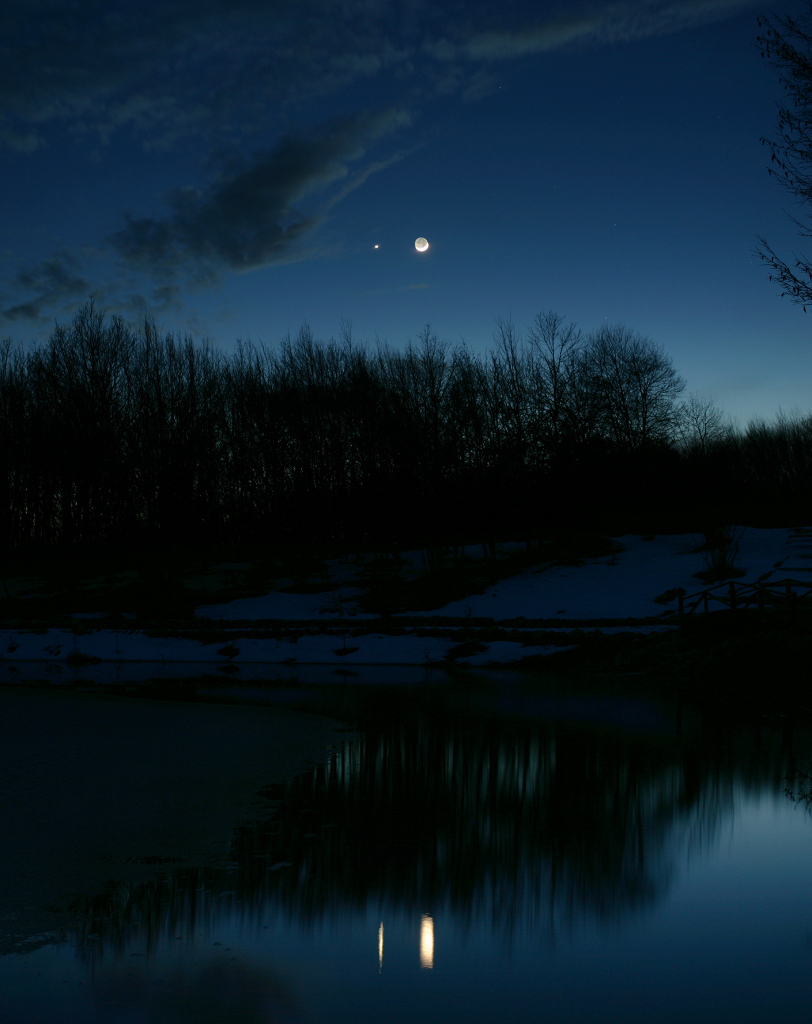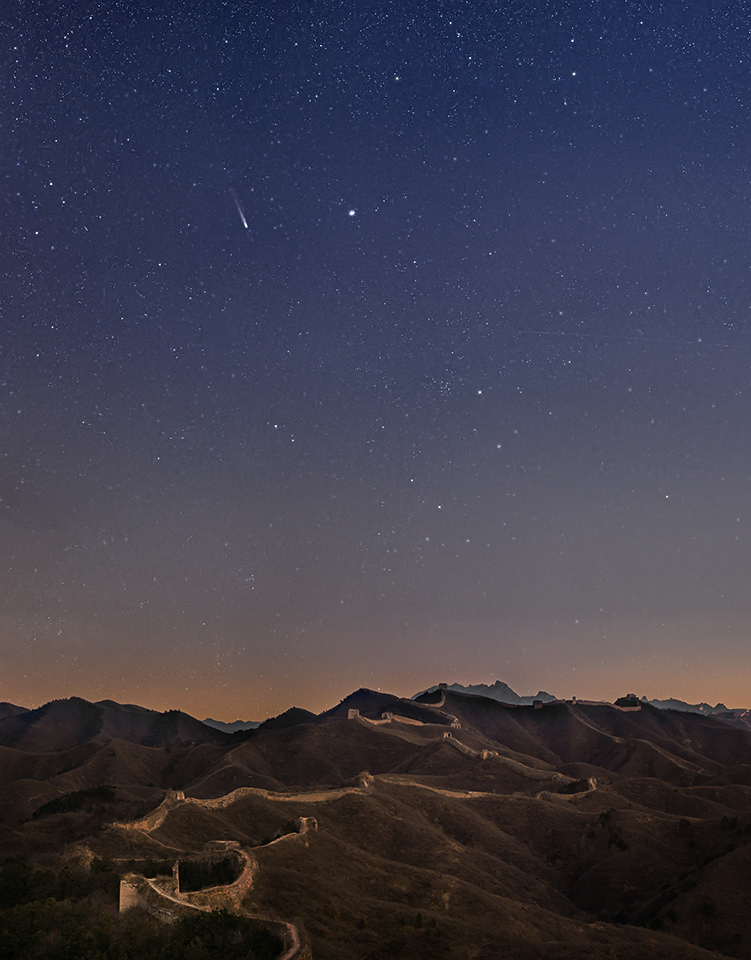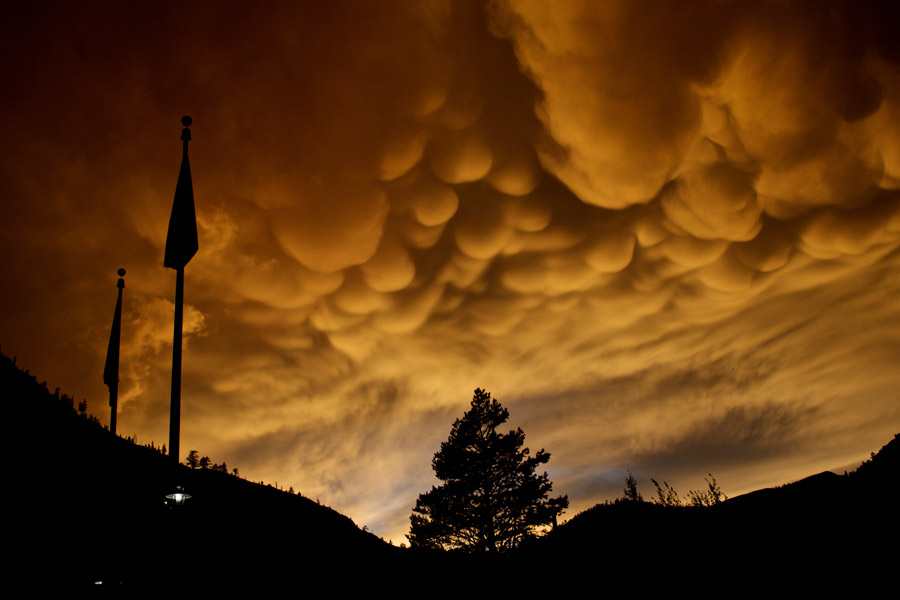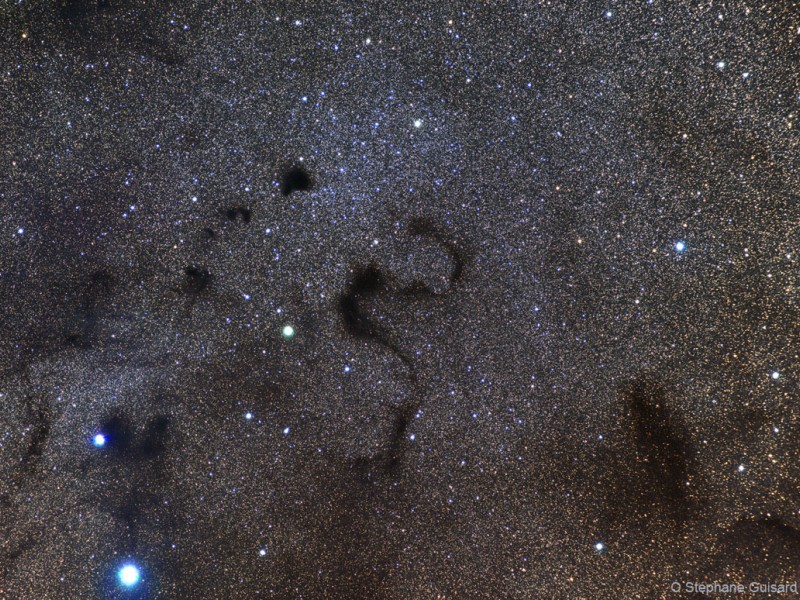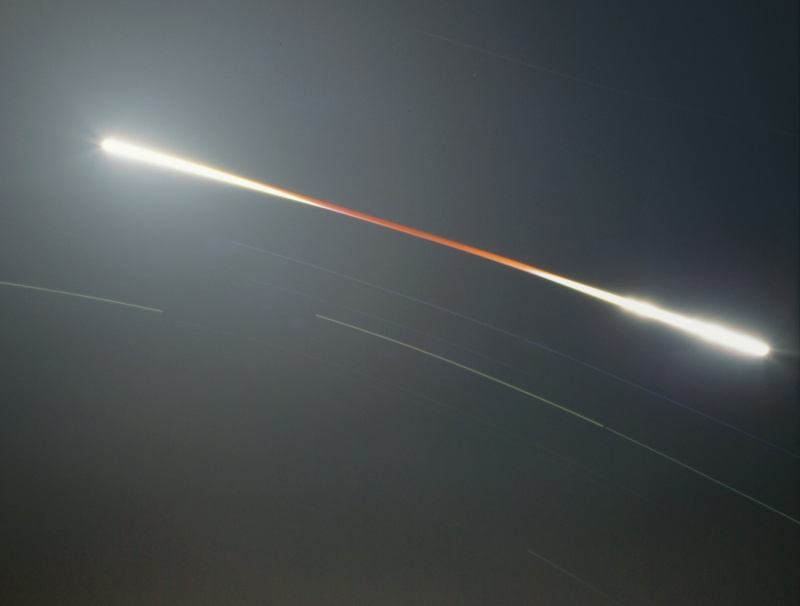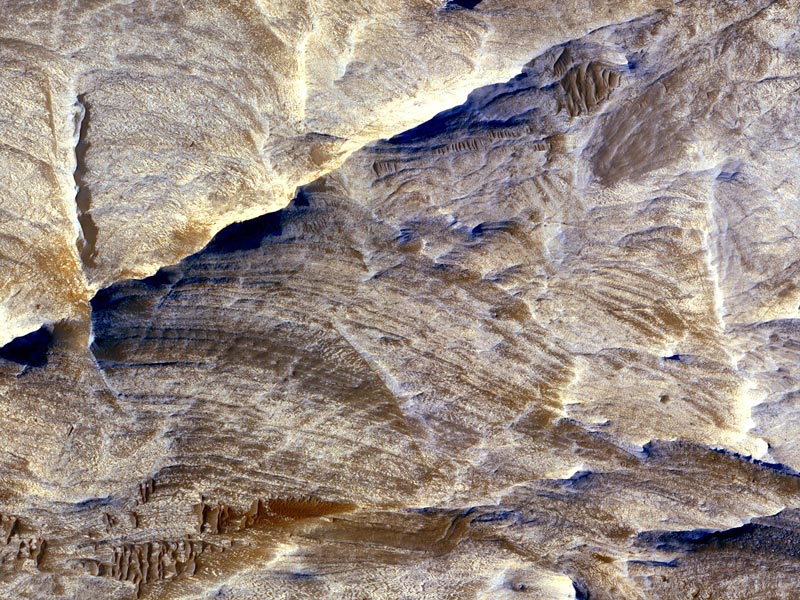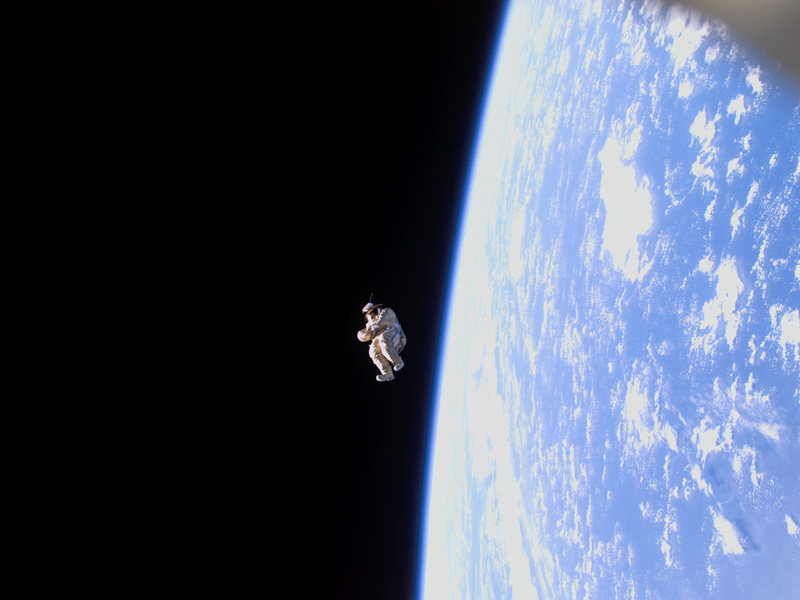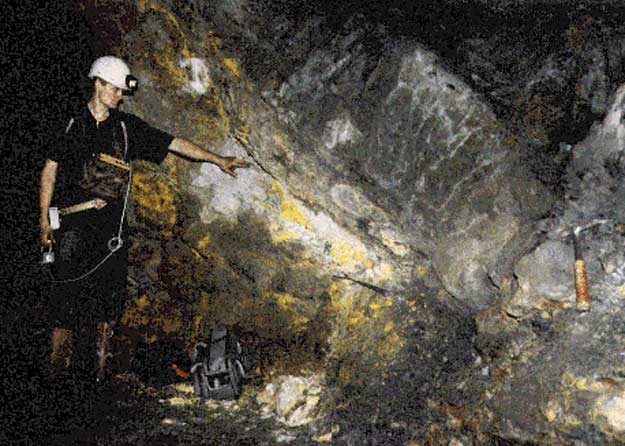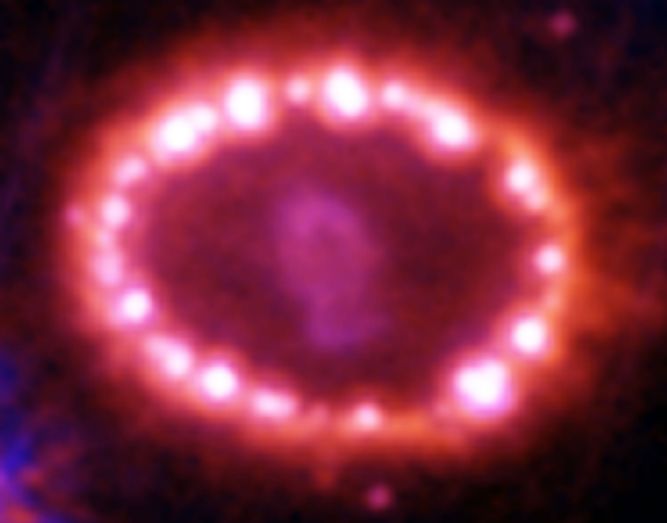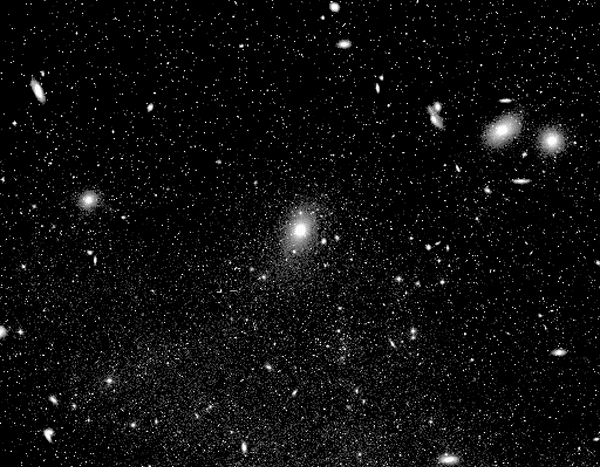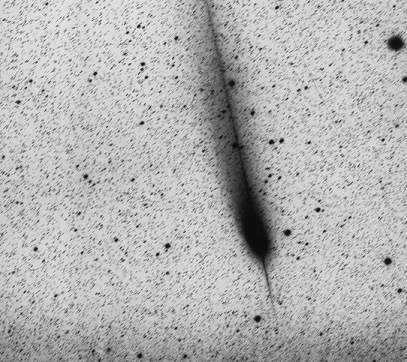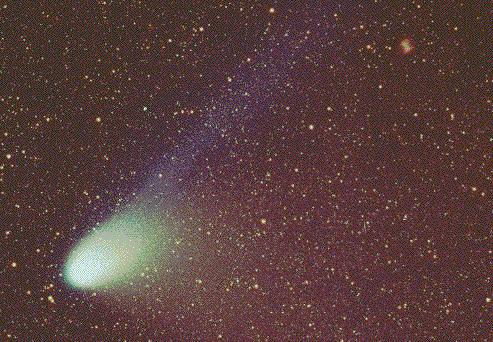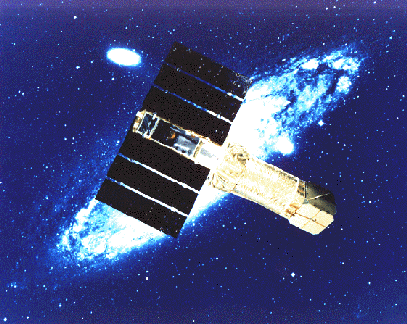| << Previous | Index | Next >> |
2015Eight years ago, an evening sky held this lovely pairing of a young crescent Moon and brilliant Venus. Seen near the western horizon, the close conjunction and its wintry reflection were captured from Bolu, Turkey, planet Earth on February 19, 2007. In the 8 Earth years since this photograph was taken Venus has orbited the Sun almost exactly 13 times, so the Sun and Venus have now returned to the same the configuration in Earth's sky. And since every 8 years the Moon also nearly repeats its phases for a given time of year, a very similar crescent Moon-Venus conjunction will again appear in planet Earth's evening skies tonight. But the February 20, 2015 version of the conjunction will also include planet Mars. Much fainter Mars will wander even closer to Venus by the evening of February 21.
2014 Fading now as it returns to the outer solar system Comet Lovejoy (C/2013 R1) still graces planet Earth's sky, a delicate apparition in binoculars or small telescopes. The comet, a relic of the solar system's formative years, is seen here rising in the morning twilight on January 12 among the stars of Ophiuchus, the Serpent Bearer. Posing near the comet is bright star Alpha Ophiuchi, also known as Rasalhague, from Arabic "the head of the serpent collector". Of course, the serpentine shape below is the ancient Great Wall of China, along the Panlongshan section northeast of Beijing. Panlongshan is translated as "a coiled dragon". A moving and fortuitous scene, it was captured with a digital camera and telephoto lens in two consecutive exposures. The exposures were merged to show a natural looking foreground and twilight sky.
2013 Why would clouds form a hexagon on Saturn? Nobody is sure. Originally discovered during the Voyager flybys of Saturn in the 1980s, nobody has ever seen anything like it anywhere else in the Solar System. If Saturn's South Pole wasn't strange enough with its rotating vortex, Saturn's North Pole might be considered even stranger. The bizarre cloud pattern is shown above in great detail by a recent image taken by the Saturn-orbiting Cassini spacecraft. This and similar images show the stability of the hexagon even 20+ years after Voyager. Movies of Saturn's North Pole show the cloud structure maintaining its hexagonal structure while rotating. Unlike individual clouds appearing like a hexagon on Earth, the Saturn cloud pattern appears to have six well defined sides of nearly equal length. Four Earths could fit inside the hexagon. Imaged from the side, the dark shadow of the Jovian planet is seen eclipsing part of its grand system of rings, partly visible on the upper right.
2012
[imghover6=http://apod.nasa.gov/apod/image/1202/ng ... st_960.jpg]http://apod.nasa.gov/apod/image/1202/ng ... ed_960.jpg[/imghover6]Image Credit: NASA, ESA, Hubble Space Telescope
2011 What's happened to these clouds? Normal cloud bottoms are flat because moist warm air that rises and cools will condense into water droplets at a very specific temperature, which usually corresponds to a very specific height. After water droplets form that air becomes an opaque cloud. Under some conditions, however, cloud pockets can develop that contain large droplets of water or ice that fall into clear air as they evaporate. Such pockets may occur in turbulent air near a thunderstorm, being seen near the top of an anvil cloud, for example. Resulting mammatus clouds can appear especially dramatic if sunlit from the side. These mammatus clouds were photographed last August over Olympic Valley, California, USA.
2010 Put a satellite in a circular orbit about 42,000 kilometers from the center of the Earth (36,000 kilometers or so above the surface) and it will orbit once in 24 hours. Because that matches Earth's rotation period, it is known as a geosynchronous orbit. If that orbit is also in the plane of the equator, the satellite will hang in the sky over a fixed location in a geostationary orbit. As predicted in the 1940s by futurist Arthur C. Clarke, geostationary orbits are in common use for communication and weather satellites, a scenario now well-known to astroimagers. Deep images of the night sky made with telescopes that follow the stars can also pick up geostationary satellites glinting in sunlight still shining far above the Earth's surface. Because they all move with the Earth's rotation against the background of stars, the satellites leave trails that seem to follow a highway across the celestial landscape. For example, in this wide view of the nearly equatorial Orion region, individual frames were added to create a 10 minute long exposure. It shows Orion's belt stars and well-known nebulae along with many 2.5 degree long geostationary satellite trails. The frames are from an ingenious movie, featuring the geostationary satellite highway.
2009 Dark nebulae snake across a gorgeous expanse of stars in this telescopic view toward the pronounceable constellation Ophiuchus and the center of our Milky Way Galaxy. In fact, the twisting central shape seen here is well known as the Snake Nebula. It is also listed as Barnard 72 (B72), one of 182 dark markings of the sky cataloged in the early 20th century by astronomer E. E. Barnard. Unlike bright emission nebulae and star clusters, Barnard's nebulae are interstellar dark clouds of obscuring gas and dust. Their shapes are visible in cosmic silhouette because they lie in the foreground along the line of sight to rich star fields and glowing stellar nurseries near the plane of our Galaxy. Many of Barnard's dark nebulae are themselves likely sites of future star formation. Barnard 72 is about 650 light years away. With bluish star 44 Ophiuchi at bottom left, the intriguing star field spans nearly 2 degrees or almost 20 light-years at the estimated distance of the Snake Nebula.
2008 No special filters - or even a telescope - are required to enjoy a leisurely lunar eclipse. In fact, watched from all over the night side of planet Earth, these regular celestial performances have entertained many casual skygazers. Still, this eye-catching picture of a lunar eclipse may look unfamiliar. To make it, astroimager Stefan Seip set his camera on a tripod and locked the shutter open during the total lunar eclipse of March 3, 2007. The resulting image records the trail of the Moon (and narrower trails of stars) sliding through the night. Reddish hues common during the total phase of a lunar eclipse, are evident along the darker, slimmer portion of the Moon trail. At least part of tonight's lunar eclipse will be visible in clear skies over the Americas, Europe, Africa and western Asia. The eclipse lasts over three hours from start to finish, with about 50 minutes of totality. Tonight's eclipse is the last total lunar eclipse until December of 2010.
2007 What created these white ridges on Mars? The images showing the white ridges, including some of the highest resolution images ever taken from Martian orbit, were recorded last year by the Mars Reconnaissance Orbiter (MRO). A current leading hypothesis is that the white ridges formed as water flowed through underground cracks and bleached and hardened the edges of surrounding rocks. Over millions of years, surface winds eroded the darker rock leaving the raised white ridges. Such water-created light-colored markings are well known here on Earth. The hypothesis is particularly interesting as underground water could have helped to support microbial life on the red world. The above image resolves surface features as small as one meter across in Candor Chasma region of huge Valles Marineris on Mars.
2006 Who dunnit? Like a scene from a space mystery movie, a spacesuit floated away from the International Space Station earlier this month, but no investigation was needed. It was pushed out by the space station crew. Dubbed Suitsat-1, the unneeded Russian Orlan spacesuit filled mostly with old clothes was fitted with a faint radio transmitter and released to orbit the Earth. Suitsat-1 will orbit once every 90 minutes until it burns up in the Earth's atmosphere within a few weeks. The suit circled the Earth twice before its radio signal became unexpectedly weak. Pictured above, the lifeless spacesuit was photographed as it drifted away from the Earth-orbiting space station earlier this month.
2005 The remnants of nuclear reactors nearly two billion years old were found in the 1970s in Africa. These reactors are thought to have occurred naturally. No natural reactors exist today, as the relative density of fissile uranium has now decayed below that needed for a sustainable reaction. Pictured above is Fossil Reactor 15, located in Oklo, Gabon. Uranium oxide remains are visible as the yellowish rock. Oklo by-products are being used today to probe the stability of the fundamental constants over cosmological time-scales and to develop more effective means for disposing of human-manufactured nuclear waste.
2004 In February 1987, light from the brightest stellar explosion seen in modern times reached Earth -- supernova SN1987A. This Hubble Space Telescope image from the sharp Advanced Camera for Surveys taken in November 2003 shows the explosion site over 16 years later. The snap shot indicates that the supernova blast wave continues to impact a pre-existing, one light-year wide ring of material, and the nascent central supernova remnant continues to expand. Like pearls on a cosmic necklace, bright hot spots produced as the blast wave heats material up to millions of degrees began to appear on the ring in the mid 1990s and have been followed across the spectrum by astronomers ever since. Supernova SN1987A lies in the Large Magellanic Cloud, a neighboring galaxy some 170,000 light-years away. That really does mean that the explosive event - the core collapse and detonation of a star about 20 times as massive as the Sun - occurred 170,000 years before February 1987.
2003 A cold wind blows from the central star of the Boomerang Nebula. Seen here in a detailed false-color image recorded in 1998 by the Hubble Space Telescope, the nebula lies about 5,000 light-years away towards the grand southern constellation of Centaurus. The symmetric cloud appears to have been created by a high-speed wind of gas and dust blowing from an aging central star at speeds of nearly 600,000 kilometers per hour. This rapid expansion has cooled molecules in the nebular gas to about one degree above absolute zero - colder than even the cosmic background radiation - making it the coldest region observed in the distant Universe. Shining with light from the central star reflected by dust, the frigid Boomerang Nebula is believed to be a star or stellar system evolving toward the planetary nebula phase.
2002 One of these stars is blinking. This star, a member of globular cluster NGC 6397, is noteworthy not just because it blinks, but because it blinks so fast and because its companion star is so atypical. Speculation holds that this might be a neutron star spun up to a rate of 274 rotations each second by the bloated red star it orbits. Matter gravitationally pulled from the bloated star likely orbits the millisecond pulsar, making it spin faster when it crashes onto the surface. The odd system might have resulted when the neutron star captured a normal star after a near collision near the globular cluster's dense center. Other collisions near the center of NGC 6397 are thought to have produced other oddities -- blue straggler stars. The Hubble Space Telescope took the above image of the colorful globular cluster.
2001 Massive star IRS4 is beginning to spread its wings. Born only about 100,000 years ago, material streaming out from this newborn star has formed the nebula dubbed Sharpless 106 Nebula (S106), pictured above. A large disk of dust and gas orbiting Infrared Source 4 (IRS4), visible in dark red near the image center, gives the nebula an hourglass shape. S106 gas near IRS4 acts as an emission nebula as it emits light after being ionized, while dust far from IRS4 reflects light from the central star and so acts as a reflection nebula. Detailed inspection of this representative color infrared image has revealed hundreds of low-mass brown dwarf stars lurking in the nebula's gas. S106 spans about 2 light-years and lies about 2000 light-years away toward the constellation of Cygnus.
2000 Pictured are several galaxies of the Virgo Cluster, the closest cluster of galaxies to our Milky Way Galaxy. The Virgo Cluster spans more than 5 degrees on the sky - about 10 times the angle made by a full Moon. It contains over 100 galaxies of many types - including spirals, ellipticals, and irregular galaxies. The Virgo Cluster is so massive that it is noticeably pulling our Galaxy toward it. The cluster contains not only galaxies filled with stars but also gas so hot it glows in X-rays. Motions of galaxies in and around clusters indicate that they contain more dark matter than any visible matter we can see. Notable bright galaxies in the Virgo Cluster include bright Messier objects such as M61, M87, M90, and M100.
1999 In December of 1990, the Space Shuttle Columbia carried an array of astronomical telescopes high above the Earth's obscuring atmosphere to observe the Universe at ultraviolet and x-ray wavelengths. The telescopes, known by the acronyms UIT, HUT, WUPPE, and BBXRT, are seen here in Columbia's payload bay against a spectacular view of the constellation Orion. The ultraviolet telescopes were mounted on a common structure - HUT is visible in this view along with a star tracker (the silver cone at the left). The mission studied solar system, galactic, and extra-galactic sources.
1998 Where is Hale-Bopp now? The Great Comet of 1997, one of the largest and most active comets ever, is outbound about 400 million miles from the sun. Too faint for viewing without telescopes or binoculars, Hale-Bopp is presently positioned in the very southerly constellation of Pictor. This "negative" image (black stars against white sky) of Hale-Bopp is the result of a 1 hour time exposure using the 1-metre European Southern Observatory Schmidt telescope on January 5. Clearly the comet still has a substantial tail, blown by the solar wind, that points generally away from the sunward direction. But look closely. A spiky "anti-tail" is also visible pointing toward the sun! It is likely that this anti-tail is composed of dust grains released from the comet nucleus which are too large to be easily pushed by the solar wind. As Hale-Bopp recedes from the sun its activity will subside but astronomers are still uncertain as to how long its tails will last. After a swing through the outer solar system and the Oort cloud, Hale-Bopp will pass through the inner solar system again ... around the year 5400.
1997 Comet Hale-Bopp is now slowly moving across the morning sky. During its trip to our inner Solar System, the comet passes in front of several notable objects. Here Comet Hale-Bopp was photographed on February 11th superposed nearly in front of the picturesque Dumbbell Nebula, visible on the upper right. Comet Hale-Bopp is now first magnitude - one of the brightest objects in the morning sky. APOD, always in search of interesting and accurate astronomy pictures, issues the following informal challenge: that Comet Hale-Bopp be photographed in color with both easily recognizable foreground and background objects. For instance, in late March, it might be possible to photograph the comet with the Eiffel Tower in the foreground and the Andromeda galaxy (M31) in the background. Such superpositions would not only contrast human and cosmic elements, but give angular perspective on the size of the comet's tail.
1996 Today marks the third anniversary of the launch of the Advanced Satellite for Cosmology and Astrophysics (ASCA; renamed from Astro D when launched). ASCA, seen here superposed on galaxy M31, is a Japanese satellite for which NASA has provided some scientific equipment. ASCA carries four large-area X-ray telescopes. At the focus of two of the telescopes is a Gas Imaging Spectrometer (GIS), while a Solid-state Imaging Spectrometer (SIS) is at the focus of the other two. ASCA has provided recent evidence that high energy cosmic rays are formed in the expanding gas from a supernova. During ASCA's three years of operation, it has also yielded valuable data on quasars, supernova remnants, dwarf novae, pulsars, clusters of galaxies, and the mysterious X-ray background radiation that appears to come from all directions.
| << Previous | Index | Next >> |
